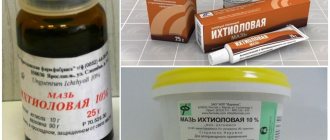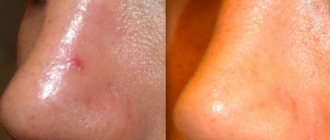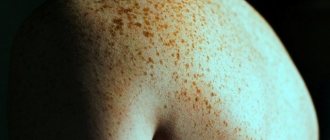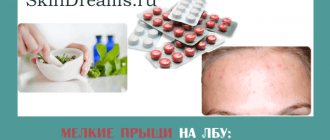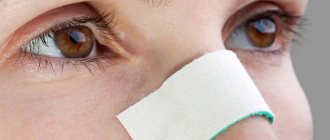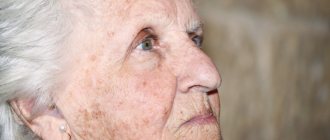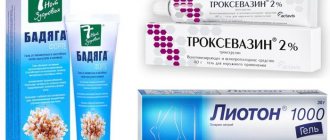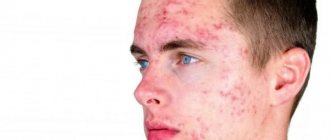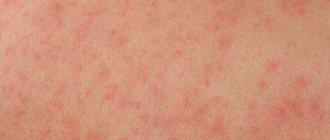Perioral dermatitis: features of pathology and treatment methods
Perioral dermatitis is an inflammation of the skin provoked by various external factors. Many people believe that the disease can only visually worsen the aesthetic appearance of the face. However, pathology can cause a number of complications and bring considerable mental discomfort. Oral dermatitis on the face can be treated under the supervision of a doctor.
Skin dermatitis can develop into a chronic form and cause significant harm to the human body. Therefore, when the first signs appear in children and adults, you need to go to the hospital. The sooner a correct diagnosis is made, the sooner the problem can be resolved. How to identify the signs of the disease and begin the correct conservative treatment?
Causes
Medical experts cannot yet name the exact causes and treatment of oral dermatitis. Often this disease is detected in patients who have been using corticosteroid drugs for a long time to treat other diseases associated with facial skin lesions. In newborns, this disease can occur due to:
- poor child skin care - irritation of delicate skin with diapers or diapers;
- contact with clothing that has been washed with active powders;
- skin injury.
How to relieve the condition
If your baby is very itchy and restless, you can try to temporarily reduce the intensity of the symptoms using the following measures:
- Hygienic procedures (washing) should be carried out without the use of synthetic general baby care products, and use products aimed at reducing allergic manifestations.
- Carry out a series of air baths indoors at a comfortable temperature or outdoors.
- Apply emollient creams or.
- You can treat your chin with decoctions of chamomile or string.
- Give antihistamines (only on the recommendation of a pediatrician).
- Causes and treatment of itching in the groin in men
- Causes and treatment of itching in the groin in men
- Why does the sides of the neck itch - About itching
- Irritation of the skin under the arms
Factors provoking the disease
The following are factors that can trigger the development of oral dermatitis in adults. This:
- skin sunburn;
- allergic reaction to personal hygiene products;
- use of personal hygiene products containing fluoride;
- the presence of hormonal diseases;
- the presence of various gynecological diseases;
- the menstrual cycle can intensify the manifestation of the disease;
- use of oral contraceptives;
- poor hygiene in the anus - damage and infection of the skin by bacteria;
- skin tendency to form acne;
- excessive sweating;
- overweight;
- reduced immunity, which contributes to the easy development of any infection;
- prolonged diarrhea.
Causes of the disease
A rash of varying sizes on the chin in women or men, the causes of which may be related to the influence of allergens on the body, should not be ignored. Irritation on the chin can occur under the influence of the following factors:
- reaction to cosmetics and personal hygiene products (for men - to aftershave products);
- negative impact of the environment;
- bad habits (response to increased stress on the body);
- consequences of infectious diseases;
- increased load on the nervous system (stress);
- negative influence of parasites in the body;
- hormonal surges and disruptions (90% occur in women);
- contact with fur or saliva of domestic animals (including ornamental rodents and birds);
- seasonal allergies associated with flowering trees and various grasses;
- negative consequences of taking medications (overdose, side effects, allergy to a component of the drug);
- insect bites;
- reactions to climatic conditions;
- influence of food components;
- reaction to ultraviolet radiation (sun, visiting a solarium).
One cannot ignore the fact that a rash on the chin can appear under the influence of dust (book, household, industrial) - it contains irritants that can provoke an allergic reaction.
Symptoms
Oral dermatitis may cause the following symptoms:
- a painful condition appears in the mouth area, constant itching, burning, redness, a feeling of dry skin, and the formation of small red pimples;
- release of clear liquid from small red pimples, eventually replacing the clear liquid with pus;
- group accumulation of pimples or formation of colonies;
- peeling of the skin in inflamed areas;
- redness under acne;
- roughness of the skin, which is associated with the presence of a large number of small pimples;
- the appearance of blepharitis or conjunctivitis;
- worsening burning sensation when treated with alcohol or cosmetics.
The rash of oral dermatitis is usually small in size. The above rashes look like ordinary red pimples. If you notice that after reducing the area of development of dermatitis, pigment spots remain in the mouth area, then it is most likely oral dermatitis. Oral dermatitis is often confused with neurodermatitis, which in most cases recurs throughout life. Therefore, it is highly recommended to consult a dermatologist to determine the type of skin rash.
Diagnostics
Timely diagnosis allows timely initiation of therapeutic measures when diagnosed with oral dermatitis.
Differential diagnosis is usually not difficult. But there are other dermatoses with a similar clinical picture, so they should be differentiated from oral dermatitis. Differentiation of dermatitis comes down to determining the location of their localization. Irritation and rash on the skin around the mouth in most cases indicates the presence of oral dermatitis. To confirm the nature of the rash, the following laboratory tests and tests are prescribed:
- blood analysis;
- skin tests;
- tests to determine the amount of immunoglobulins;
- in some cases, biopsy;
- bacterial culture of scrapings;
- analysis for dysbacteriosis;
- biochemical blood test to monitor liver and kidney function;
- assessment of the general condition of the body.
The results of all tests are assessed by a dermatologist, and if the dermatitis is not confirmed, the patient is sent for further examination.
Oral dermatitis in children
Oral dermatitis on the facial skin of a child is expressed by certain features. In children, the color of the rash can range from pale pink to yellow-brown. In children, it is necessary to clarify the cause of the rash and treat it. If this is not done, then a cosmetic defect in the form of age spots may remain on the child’s sensitive skin. To clarify the cause, a microbiological examination of the child's skin scraping is carried out.
Children more often suffer from such facial dermatitis, which has an asthmatic syndrome. This is due to the fact that they are taking medications that can be a trigger for oral dermatitis. When the child feels a decrease in the number of attacks, he practically stops using the inhaler. This leads to what is called withdrawal syndrome, which can affect hormonal levels. In children, this disease occurs without much discomfort. A child can only experience aesthetic discomfort from the presence of a visual flaw on the face. It is worth saying that oral dermatitis in children is most often localized around the mouth, but can also be around the eyes.
There are two stages of treatment for oral dermatitis in children (photos of the manifestations of the disease are in the article).
- Discontinue all medications that may affect the development of oral rash if treatment of the underlying disease allows this. First of all, it is necessary to cancel all hormonal medications. Then eliminate all corticosteroids. After this, it is necessary to prevent the withdrawal syndrome from having a strong impact on the body. At this stage, it is worth not only canceling hormonal therapy, but also stopping the use of aggressive cosmetic products. This is due to the fact that damaged skin may be sensitive to their components. If this stage does not lead to improvement, then the second stage is carried out.
- At the second stage, the causative agent of oral dermatitis is completely destroyed. There are many antibacterial drugs available for such events. The type and dosage of the drug will be prescribed by the doctor after a complete medical examination. Treatment with these drugs lasts for two months. It is important to carry out regular prophylaxis after complete cure of oral dermatitis in a child, this will avoid re-charging. Folk remedies are most often used for prevention.
Causes of oral dermatitis
Dermatitis on the cheeks, chin and around the mouth often develops due to a weakening of the skin's protective barrier. It is difficult to name a single cause of the problem, but over the years of practice, factors have been identified that have a direct impact on the occurrence of inflammation, among which are:
- natural: high humidity, active sun, wind, frost;
- sudden climate change;
- decreased immunity;
- increased sensitivity to allergens;
- predisposition to allergies;
- increased sensitivity of facial skin;
- use of cosmetics: nourishing, moisturizing, foundation creams, tonics, lotions, soaps;
Carrying out cosmetic procedures in which the upper layers of the epidermis are injured:
- chemical and mechanical peelings and scrubs;
- use of fluoride toothpaste and preventative mouth rinse;
- the use of hormonal ointments, inhalations and aerosols based on corticosteroids, which irritate the skin and provoke the development of dermatitis;
- long-term use of hormonal drugs, including birth control pills;
- disruptions in the gastrointestinal tract, dysbacteriosis;
- damage by fungi and bacteria to hair follicles
- hormonal and endocrine imbalances.
Pharmacy products
To treat oral dermatitis (photo of its manifestations above), topical medications can be used. Such means are antibacterial ointments. They not only allow you to quickly relieve the symptoms of dermatitis, but also have a positive effect with an integrated approach. Glucocorticoid hormones can be added to such drugs in order to give the drugs anti-inflammatory properties. Such ointments may even contain antibiotics. Before using such ointments, you should consult a doctor.
Listed below are ointments for the face for the treatment of oral dermatitis (photos of some drugs below).
- "Laticort". Consists of the active ingredient hydrocortisone butyrate. This drug is a glucocorticoid drug that is used externally.
- "Pimafukort". Consists of the active ingredients hydrocortisone, natamycin, neomycin. A combined drug with antimicrobial, antifungal and local anti-inflammatory effects.
- "Cortomycetin". Consists of the active ingredients hydrocortisone and chloramphenicol. A combined drug with anti-inflammatory, antiallergic and antimicrobial effects.
- "Gyoksizon", "Oxycort". They consist of the active ingredients hydrocortisone and oxytetracycline. A combined drug with antibacterial and anti-inflammatory effects.
- "Dermovate", "Powercourt cream". They consist of the active ingredient clobetasol. This drug stands out among others for its very powerful effect. It is used only in severe cases.
If oral dermatitis is accompanied by another skin disease and the affected area is large, then antihistamines in the form of tablets are used for complex treatment. Their action is aimed at a general anti-inflammatory effect on the body. The following antihistamines are used to treat oral dermatitis on the face (the photo of the manifestations of the disease was above):
- "Diphenhydramine";
- "Diazolin";
- "Suprastin";
- "Tavegil";
- "Fenkarol".
Corticosteroids are also prescribed in tablet form. These drugs are prescribed if dermatitis is not only on the face, but also on other parts of the body. The effect of this drug is similar to hormone therapy. Such drugs have a pronounced anti-inflammatory effect. Such drugs for the treatment of oral dermatitis include:
- "Prednisol";
- "Flumetasone";
- "Dexamethasone";
- "Triamcinolone".
If the cause of the development of dermatitis was the influence of one’s own immunity, then immunosuppressants should be used, the action of which is aimed at suppressing one’s own immunity.
Treatment
Dermatitis is a disease that, like other diseases, should be treated and not neglected. If you do nothing and ignore the disease, the rash can spread throughout the face.
This process is not quick, so it can be prevented in time. The disease can progress over months and years. If you immediately take treatment measures, you can get rid of dermatitis within two weeks.
To begin treatment, you must completely abandon any cosmetics and medications. You should regularly do various skin cleansing procedures. To do this, use regular warm water along with baby soap.
The skin should be washed thoroughly and wiped dry. If you use a toothpaste containing fluoride, it should be replaced with another that does not contain this element. When the dermatitis is completely cured, you can brush your teeth again with fluoride paste.
If various creams or ointments are used that contain hormones, they should also be replaced with others.
You should be prepared for the fact that in the very first stages of the development of dermatitis, the disease will be very pronounced. But you shouldn’t be afraid of this and panic, because after a few days the appearance of your skin will become more or less acceptable.
When the papular rashes disappear, you should not use any cosmetics or medications for some time.
Traditional treatment
Alternative treatment involves the use of the following recipes.
- The glycerin mixture is used to locally moisturize the skin. Due to its oily consistency, it is suitable for preventing dry skin. This mixture is made by adding some glycerin and starch to whole milk until a viscous mixture is obtained. This ointment is applied before bedtime to the area affected by oral dermatitis.
- Cranberry ointment can help with severe itching, burning, and skin irritation at the site of oral dermatitis. The ointment is made by mixing 50 g of freshly squeezed juice with 200 grams of Vaseline. The resulting ointment can be applied both to the affected area and beyond.
- Ointment from St. John's wort leaves. Grind the leaves of St. John's wort in a wooden mortar. Pour boiling water over the resulting dust and leave it alone for half a month. The prepared tincture must be shaken regularly. After infusion, the mixture is filtered and stored in a dark place. The ointment is applied to the skin in the affected area. After applying this ointment, it is recommended not to go outside, this is due to the fact that the components of St. John's wort leaves can increase the skin's sensitivity to the sun.
Compresses
For dermatitis around the mouth, the following compresses are used:
- A compress with a decoction of birch buds effectively eliminates irritation and other signs of oral dermatitis. Prepare a decoction of five tablespoons of birch buds. These buds are poured with a glass of boiling water and left for about ten minutes. The resulting broth is filtered and stored in a cool place. After soaking the gauze with liquid, place it on the skin at the site of the lesion.
- Oak bark decoction. The bark is crushed and poured with a glass of boiling water and continued cooking in a water bath for ten minutes. The resulting broth is filtered and consumed as in the previous recipe.
- Juice or pulp of raw potatoes. Potato compresses are good for getting rid of the symptoms of dermatitis. Prepare the composition for the compress by grinding it in a blender or grating it. Then the resulting paste is applied to the skin, secured with a bandage.
- Marsh marigold leaves are recommended for use as an anti-inflammatory or analgesic for oral dermatitis. Pour boiling water over crushed marsh marigold leaves, after which they are applied to the skin through gauze or a napkin.
Diet
The diet for oral dermatitis should mainly be aimed at rapid skin regeneration and relieving inflammation. Avoid the following foods that may aggravate your skin condition:
- various fast food, for example, chips, nuts, crackers, etc.;
- products that can cause allergic skin conditions;
- carbonated drinks, as they contain large amounts of sugar and other additives that are harmful to the body;
- limit alcohol intake;
- bakery products made from wheat flour;
- sweets;
- mushrooms, as they may contain toxins that affect the skin;
- fatty meats;
- soy products.
For oral dermatitis, you can consume the following foods that can prevent inflammation:
- lean meats;
- black bread;
- cow's milk products, which are rich in bacteria beneficial to the entire body;
- freshly squeezed juices rich in vitamins;
- herbs, for example parsley, dill, basil, etc.;
- any vegetables;
- tea - this drink will help remove toxins from the body that can form during the development of dermatitis;
- any cereals.
Prevention of oral dermatitis
To minimize the risk, preventive measures are taken. They are available for both newborns and adults. Prevention of the disease in newborns comes down to:
- regular child skin care;
- replacing aggressive powders with ones that are safer for baby’s skin;
- replacing tight diapers with looser ones;
- less strong wrapping of the child.
The following prevention measures are effective for adults:
- avoiding burns to the oral cavity;
- avoiding sunburn of the facial skin;
- replacement of aggressive personal hygiene products that cause allergic reactions;
- normalization of hormone levels in the body;
- stop using oral contraceptives;
- If you sweat heavily, constantly use napkins;
- you should constantly monitor the level of immunity; if the doctor notices a deviation, then this level must be brought back to normal;
- refuse fluoride-containing toothpastes;
- quitting smoking and drinking alcohol;
- refuse to apply tattoos to the skin of the face;
- stop taking glucocorticoid drugs.
Judging by the reviews, the treatment of oral dermatitis on the face with the above listed remedies is quite effective. The main thing is to follow the recommendations of specialists.
Causes of the rash
The causes of rashes in the mouth area in women can only be determined by medical specialists. Below are the main factors that trigger the development of a chin rash.
In order to choose the right algorithm of action, you need to decide what factors initiated the appearance of spots, peeling, papules or rashes on the face.
- Physiological manifestations in infants during the neonatal period - the first weeks and months of life, the so-called “newborn acne”. This phenomenon occurs in 20–30% of infants and is not at all dangerous for them, does not require treatment and goes away on its own after the hormone levels in the blood are finally adjusted. A characteristic feature is the absence of clogged pores. Sometimes they do not have a specific coloring and are only felt tactilely when running your palm over the skin.
- Food allergies. In appearance it resembles a nettle burn. It can appear not only in the chin and face, but spread to the back, arms, legs and tummy. With this allergic pathology, dermatitis occupies the face, buttocks, legs, forearms, and tummy. In some cases, with atopic dermatitis, the tonsils and adenoids become enlarged and swelling occurs. In a chronic course, it provokes the appearance of scabs, which periodically become wet. When breastfeeding, allergens can come through mother's milk. On artificial nutrition, the onset of symptoms can be provoked by the presence of proteins in the mixture, which cause skin reactions if used early or incorrectly. The disease is diagnosed exclusively by a doctor.
- Reaction to drugs. It especially often occurs in response to taking antibiotics or hormone-containing drugs. Also, similar reactions are provoked by multivitamin complexes, colored tablet shells and colored preparations, many products with plant extracts, and iron-containing medications.
- Contact dermatitis. It looks like skin chafing caused by synthetic detergents, laundry detergents, and fabric softeners. The appearance of a rash can occur due to contact with a certain type of fabric, most often synthetics or natural wool.
- Prickly heat. Despite the fact that it is most often localized on the neck, chest and inside the folds, it sometimes appears in the chin area. Occurs due to the release of sweat after overheating. Miliaria does not require specific therapy; it is enough to rinse the areas of manifestation with water and apply powder.
- Hives. Appears for various reasons: due to exposure to cold air or excessive heat, exposure to sunlight or excitement. Another reason is tight friction against the elastic band on clothing or child car seat belts in the car. If the symptoms do not go away for a long time, you should contact your pediatrician, who will prescribe the use of antihistamines.
- Infectious rash. Occurs in response to the development of an infectious disease in the body. Depending on the type of infection, their intensity and appearance differ. Caused by three-day fever, scarlet fever, chickenpox, measles, rubella or enterovirus infection “mouth-foot-palm”. The goal of the treatment prescribed by the doctor is not to get rid of the rash, but to fight the pathogen.
